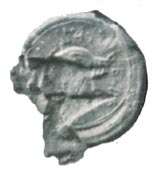Stracimir Balšić
| Stracimir Balšić Strazimir Balsha | |
|---|---|
| Lord of Zeta | |
 Seal of the Balsha brothers | |
| Died | 15 January 1373 |
| Spouse | Irene Duklina Milica Mrnjavčević |
| Issue | Gjergj II Balsha Gojko Balsha Ivaniš Balsha |
| House | Balsha |
| Father | Balsha I |
Stracimir Balšić (Serbian Cyrillic: Страцимир Балшић; Albanian: Strazimir Balsha)[1] or Strazimir Balsha fl. 1360 – 15 January 1373) was a Lord of Zeta, alongside his two brothers Đurađ I and Balša II, in ca. 1362–1372. The Balšić family took over Zeta, by 1362, during the fall of the Serbian Empire. Stracimir took monastic vows and died in 1373. He left three sons, one of whom later became the Lord of Zeta (Đurađ II).
Life
Stracimir was the eldest[2] son of Balša I (his two brothers were Balša II and Đurađ I), a petty nobleman who held only one village during the rule of Serbian Emperor Stephen Dušan the Mighty (r. 1331–1355).[3] Some years after the death of the Emperor, Balša I and his sons managed to expand their local power, beginning by taking lands previously held by Lord Žarko (south of Lake Skadar, Lower Zeta).[3] In 1361, during a conflict between the Republic of Ragusa and Vojislav Vojinović, they supported Ragusa.[4] For this, they became Ragusan citizens in May or 3 July 1361. In 1362, the three brothers killed[5] čelnik Đuraš Ilijić, and expanded further into Upper Zeta.[3] Their father died the same year.[3] The brothers succeeded their father ruling Zeta together, though Đurađ I was the major figure.[2] They were called "oblastni gospodari" ("provincial lords") in charters of Emperor Uroš V the Weak (r. 1355–1371).[3] In 1368, after Đurađ I's attack on Kotor, the Serbian court deemed him a rebel. The brothers converted from Serbian Orthodoxy to Roman Catholicism in 1368–1369, in order to further their coastal ambitions.[6] Stracimir married firstly Irene Duklina, and secondly Milica Mrnjavčević, the daughter of Serbian King Vukašin Mrnjavčević.[7] He had three sons with Milica:
- Đurađ II (1385–1403), married Jelena Lazarević[8]
- Gojko (died before 1372)
- Ivaniš (died before 1372)
Stracimir became a monk and was tonsured before his death on 15 January 1373, and the power was now shared by Đurađ I, Balša II, and Stracimir's son Đurađ II, who each held an individual appanage.[2]
Notes
References
- ↑ Mueller C., Reinhard (2021). Late Medieval Venice: Economy and Society. Italy: Viella Libreria Editrice. p. 579.
- ↑ 2.0 2.1 2.2 Fine 1994, p. 386
- ↑ 3.0 3.1 3.2 3.3 3.4 Fajfrić 2000, ch. 44, "Oblasni gospodari"
- ↑ Fine 1994, p. 361
- ↑ Fine 1994, p. 359
- ↑ Fine 1994, p. 362
- ↑ Soulis 1984, p. 270
- ↑ Fine 1994, p. 389
Sources
- Fajfrić, Željko (2000) [1998], Sveta loza Stefana Nemanje, Belgrade: Tehnologije, izdavastvo, agencija Janus
- Fine, John Van Antwerp (1994). The Late Medieval Balkans: A Critical Survey from the Late Twelfth Century to the Ottoman Conquest. Michigan: The University of Michigan Press. ISBN 0-472-08260-4.
- Soulis, George Christos (1984), The Serbs and Byzantium during the reign of Tsar Stephen Dušan (1331–1355) and his successors, Dumbarton Oaks, ISBN 0-88402-137-8